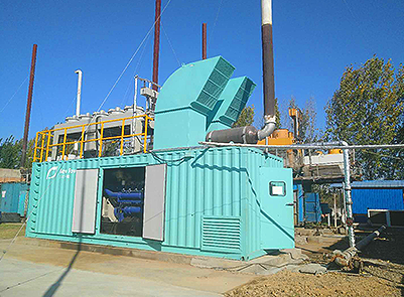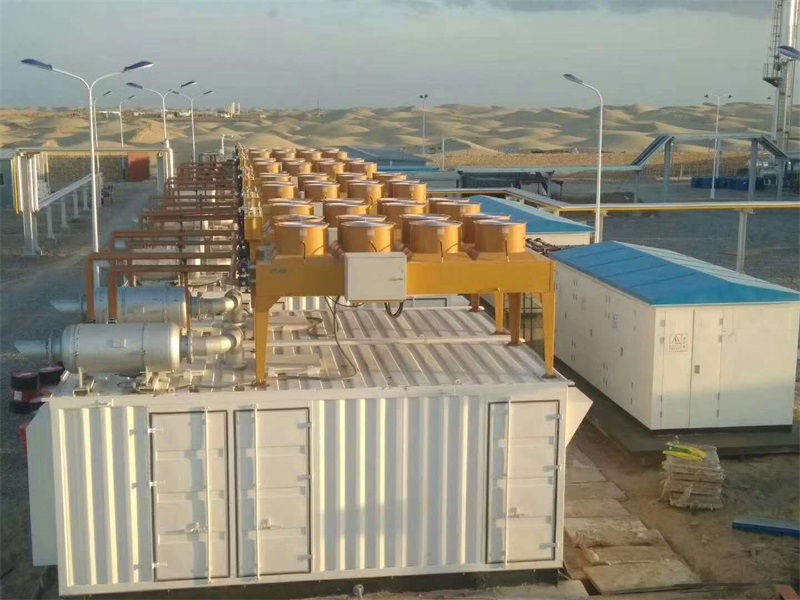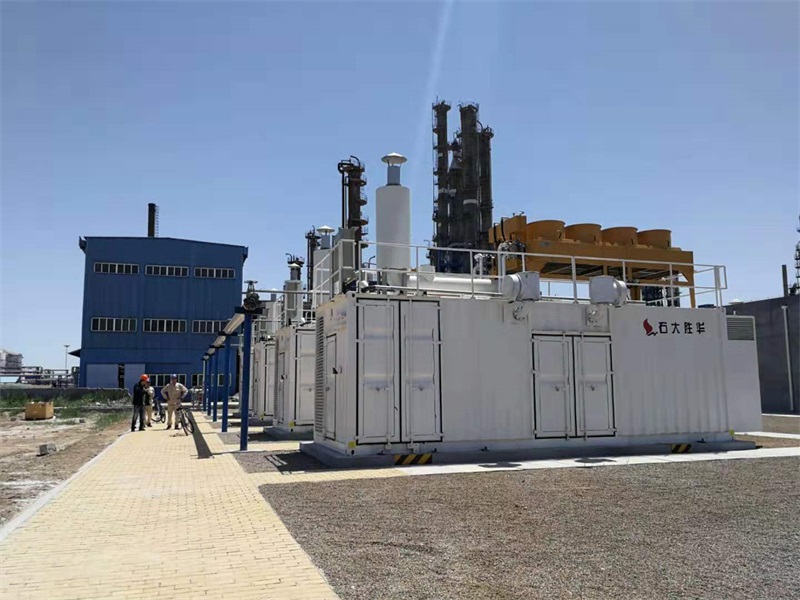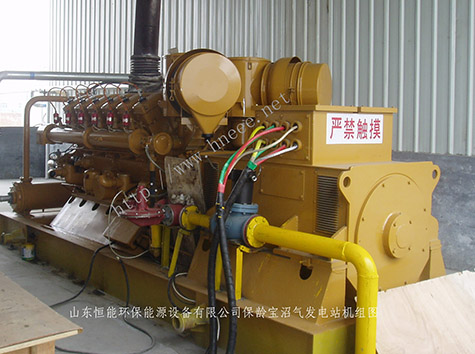燃?xì)獍l(fā)電機(jī)組尾氣余熱利用效果
目前燃料的能量只有約35%被燃?xì)獍l(fā)電機(jī)組轉(zhuǎn)化為電能,約有30%隨廢氣排出,25%被燃?xì)獍l(fā)電機(jī)組冷卻水帶走,通過機(jī)身散發(fā)等其它損失約占10%左右,廢氣和換熱器損失的功率比有用功還多。
At present, only about 35% of the fuel energy is converted into electric energy by the Gas-fired power plant unit, about 30% is discharged with exhaust gas, 25% is taken away by the cooling water of the Gas-fired power plant unit, and other losses such as emission through the fuselage account for about 10%. Waste gas and heat exchanger lose more power than useful work.
在我國(guó),目前占燃?xì)獍l(fā)電機(jī)組燃料近55%熱值的廢氣和冷卻水余熱資源基本上被白白浪費(fèi)掉,燃?xì)獍l(fā)電機(jī)組余熱利用技術(shù)的就是來(lái)實(shí)現(xiàn)將原本白白浪費(fèi)掉的熱資源充分利用的系統(tǒng)。
In China, waste gas and cooling water waste heat resources, which currently account for nearly 55% of the calorific value of Gas-fired power plant unit fuel, are basically wasted. The waste heat utilization technology of Gas-fired power plant unit is to realize the system of making full use of the waste heat resources.
隨著人民生活質(zhì)量的提高,制冷和采暖越來(lái)越普及,能源消耗越來(lái)越大,同時(shí)燃?xì)獍l(fā)電機(jī)組余熱資源目前沒有得到綜合利用,消耗了大量能源。根據(jù)燃?xì)獍l(fā)電機(jī)組余熱利用現(xiàn)狀,我公司發(fā)揮技術(shù)優(yōu)勢(shì),研制開發(fā)了一套燃?xì)鈾C(jī)組煙氣余熱利用配套熱管式余熱鍋爐及熱管換熱器,產(chǎn)生的過熱蒸汽和熱水用于余熱發(fā)電及企業(yè)內(nèi)部冷熱電聯(lián)供。
With the improvement of people's living quality, refrigeration and heating are becoming more and more popular, and energy consumption is increasing. At the same time, the waste heat resources of Gas-fired power plant units are not comprehensively utilized at present, which consumes a lot of energy. According to the current situation of waste heat utilization of Gas-fired power plant units, our company has developed a set of heat pipe type waste heat boiler and heat pipe heat exchanger for waste heat utilization of flue gas of gas-fired power units by giving full play to its technical advantages, and the Superheated steam and hot water generated are used for waste heat power generation and internal combined cooling, heating and power supply of enterprises.
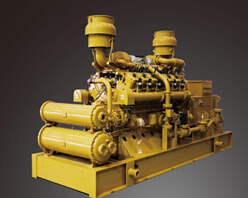

在燃?xì)鈾C(jī)組發(fā)電的同時(shí),以機(jī)組廢氣的熱量為能源,煙氣通過熱管余熱鍋爐及熱管換熱器,加熱介質(zhì)水,熱管余熱鍋爐產(chǎn)生的過熱蒸汽用于余熱發(fā)電,熱管換熱器產(chǎn)生的熱水通過溴化鋰?yán)渌畽C(jī)組制冷或制熱,系統(tǒng)原理如下圖所示:
At the same time of power generation of gas turbine unit, the heat of unit exhaust gas is taken as the energy source. Flue gas passes through heat pipe waste heat boiler and heat pipe heat exchanger, heating medium water, Superheated steam generated by heat pipe waste heat boiler is used for waste heat power generation, and hot water generated by heat pipe heat exchanger is cooled or heated by Lithium bromide water chiller. The system principle is shown in the following figure:
余熱制冷供暖系統(tǒng)流程圖
Flow diagram of waste heat refrigeration and heating system
綜合利用燃?xì)獍l(fā)電機(jī)組熱能主要從三個(gè)方面著手:即電力供應(yīng)采暖洗浴等供熱以及夏季空調(diào)制冷。在綜合利用的設(shè)計(jì)過程中應(yīng)充分考慮以下幾方面的因素:
Comprehensive utilization of heat energy of Gas-fired power plant units mainly starts from three aspects: power supply, heating and bathing, and air conditioning and refrigeration in summer. In the design process of comprehensive utilization, the following factors should be fully considered:
利用應(yīng)避免對(duì)燃?xì)獍l(fā)電機(jī)組的性能產(chǎn)生大的影響,即不影響燃?xì)獍l(fā)電機(jī)組的正常運(yùn)行及功率輸出;
The utilization shall avoid great influence on the performance of Gas-fired power plant unit, that is, it shall not affect the normal operation and power output of Gas-fired power plant unit;
排氣總管到余熱利用系統(tǒng)之間的距離應(yīng)盡可能短,同時(shí)應(yīng)充分考慮排氣管的隔熱保溫,減少?gòu)娜細(xì)獍l(fā)電機(jī)組排氣出口至熱管余熱鍋爐的熱量損失;
The distance between the exhaust header and the waste heat utilization system shall be as short as possible, and the heat insulation of the exhaust pipe shall be fully considered to reduce the heat loss from the exhaust outlet of the Gas-fired power plant unit to the heat pipe waste heat boiler;
需要考慮燃?xì)獍l(fā)電機(jī)組負(fù)荷變化時(shí)給余熱發(fā)電及余熱制冷制熱造成的影響,避免因負(fù)荷變化使制冷(或制熱)過量或能力不足;
It is necessary to consider the impact on waste heat power generation and waste heat refrigeration and heating caused by load change of Gas-fired power plant unit to avoid excessive refrigeration (or heating) or insufficient capacity due to load change;
考慮到整個(gè)流程控制范圍大項(xiàng)點(diǎn)多操作難度大等因素,整個(gè)系統(tǒng)應(yīng)盡可能實(shí)行電氣自動(dòng)化控制和監(jiān)測(cè);
Considering the large control range, multiple items, and high operational difficulty of the entire process, the entire system should implement electrical automation control and monitoring as much as possible;
整套系統(tǒng)應(yīng)充分考慮維護(hù)操作以及使用的安全性。
The entire system should fully consider the safety of maintenance operations and use.
 在線咨詢
在線咨詢 官方二維碼
官方二維碼




 當(dāng)前位置:
當(dāng)前位置: 2023.07.24
2023.07.24
